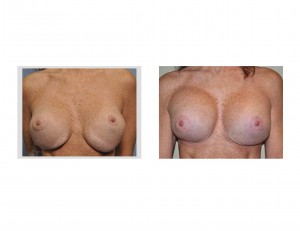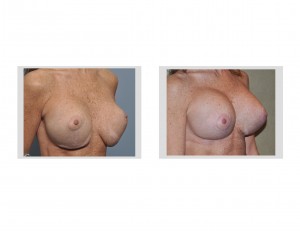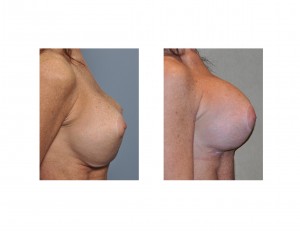Background: The placement of breast implants is largely debated about whether it should be above or below the pectoralis muscle. While this is an extremely important decision, the implant’s relationship to the inframammary fold also has relevance. It will have an influence on how the augmented breast shape will look, regardless of the tissue plane location of the implant.

When a breast implant drops down below the established or released inframammary fold, it is known an implant bottoming out. It is obvious to an observer as an implant bulge on the bottom of the breast. It is most obvious to the patient as a lack of adequate upper pole fullness. The implant may cause some persistent discomfort as it pushes downward onto the abdominal tissues and can make it difficult to wear bras comfortably. Depending upon how much the implant has dropped will determine what surgical technique is needed to fix it.
Case Study: This 40 year-old female presented with bottoming out of both of her breast implants. Her history was that she had a combined full breast lift with submuscular silicone implants placed over one year ago. Within weeks after surgery her breast implants ‘fell’ and were too low, worse on her left side than her right. A revision to reposition her implants was done at four and seven months after her original surgery but both efforts resulted in the implants falling back down with no significant improvement.



Case Highlights:
1) Bottoming out of breast implants occurs when there is disruption of the inframammary fold attachments. It can occur in any procedure which involves the placement of an implant.
2) Repositioning and resuspension of the implants back up onto the chest wall requires re-establishment of the inframammary fold through a variety of techniques.
3) The stability of breast implant positioning after a bottoming out repair can not be determined for a minimum of three to six months after surgery.
Dr. Barry Eppley
Indianapolis, Indiana


